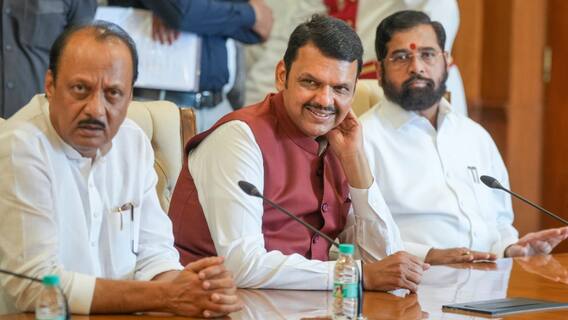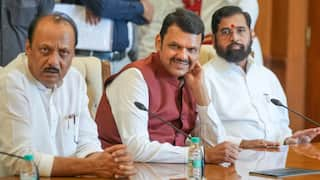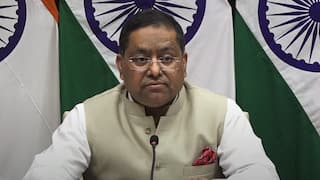India Among Five Major Economies In Race To Become A Net-Zero Economy, Says Report. Here's How
India is projected to be an embodiment of successful net-zero development. In the last few years, the nation has increased investment in the electric vehicle industry, and renewable energy sector.

India is among the five major economies in the race to lead the global supply of zero-carbon technologies such as renewable energy and electric vehicles, according to a report titled 'Competing in the new zero-carbon industrial era'. The authors of the report are Neil Makaroff and Linda Kalcher of Strategic Perspectives, a pan-European think tank whose mission is to promote effective climate action. The five major economies are China, the European Union, the United States, Japan, and India. The manufacturing and deployment of zero-carbon technologies can create jobs, and result in competitive advantages and the reduction of emissions in key sectors. These net-zero transition plans can lead to a new industrial era that will be known for its zero-carbon technologies.
India, China, the EU, the US and Japan are the five economies that play an important role in shaping the global energy landscape, and will lead the deployment of net-zero technologies worldwide.
The report states that India cannot be compared with the other economies on equal footing because of the nation's different entry position on economic development. If additional investments can be secured, India can fulfil its ambitions of becoming a significant part of the global net-zero supply chain, and benefit from the transition in the near future.
ALSO READ (EXCLUSIVE) | Climate Finance From Rich Nations, Capacity Building, Carbon Markets — How India Can Meet Its G20 Climate Goals
Some transition plans that are being converted into industrial strategies include National transition plans such as the European Green Deal, India's Energy Conservation Act, China's 14th Five-Year Plan, the US Inflation Reduction Act, and Japan's Green Growth Strategy.
According to the report, these national transition plans have the potential to create millions of quality jobs. The renewable energy sector could employ about 40 million people by 2050, the International Renewable Energy Agency (IRENA) assumes. By positioning themselves as global leaders in the transition to net-zero, India, China, the EU, the US, and Japan aim to shape markets and bring new innovative strategies. Not only will the net-zero transition reduce all greenhouse gas emissions along the value chain, but is also expected to help countries strengthen their energy security, economic prosperity, and industrial competitiveness.
MUST READ (EXCLUSIVE) | Water Scarcity, Sea Level Rise, Intensified Floods, Droughts, Heat Waves – Climate Threats For India
How countries are increasing their net-zero investment
Nations have amplified their net-zero investment by switching to electric vehicles and renewable energy. These net-zero technologies are expected to overtake fossil fuel investment this year, according to the report.
However, nations that do not increase net-zero investment may not be able to enter this new industrial era, and are likely to remain heavily dependent on gas, coal and oil.
India, the US, the EU, China and Japan have rapidly scaled up the deployment of important zero-carbon technologies through plans and national policy laws. Since countries have increased the use of renewable energy technologies and electric equipment that use zero-carbon electricity, it is believed that these will substitute the use of fossil fuels soon.
In order for all countries to accelerate their net-zero transition and development, it is important that international financial reforms are implemented.
ALSO READ | Science For Everyone: What Are El Niño And La Niña? Know How They Affect Global Climate
What hurdles lie in India’s path to becoming a net-zero economy?
While India is in the race to lead the global supply of zero-carbon technologies, and acts as an excellent example of an emerging economy with policy ambitions that can show a transition to a net-zero economy, the nation faces several challenges in the new industrial era.
India does not have large lithium battery production yet, but intends to build around 12 gigafactories (large-scale manufacturing factories for rechargeable batteries used in electric vehicles) by 2030. This will boost domestic production, and also allow the country to export lithium ion batteries.
India has less financial capacity to invest in research and development, and is still very dependent on technological transfer. The country still relies on Chinese imports.
India also has less capital to spend on research, development, and demonstration (RD&D). If India intends to scale up patenting and technological innovation, it will require RD&D investment, and technology transfers from international partners.
ALSO READ | Science For Everyone: The Importance of Greenhouse Gases, And Their Role in Climate Change
While India's cooperation with the US and some EU countries shows that the country is heading in the direction of improved technological innovations through RD&D investment, the capital is insufficient as of now to place India in the global zero-carbon technology value chain.
The nation can become a net-zero economy at a faster pace if it receives adequate financial support.
India can effectively implement its decarbonisation plans if accurate investments are made.
Therefore, India can secure its transition to a net-zero carbon, and position itself in the net-zero supply chain, only by developing indigenous zero-carbon technology factories, and investing in net-zero innovations.
How India is making efforts to transition to a net-zero economy
India is projected to be an embodiment of successful net-zero development. In the last few years, nation has increased investment in the electric vehicle industry, and renewable energy sector.
India’s increased investment in electric vehicle industry
Between 2022 and 2030, the electric vehicle industry is projected to grow at a compound annual growth rate of 49 per cent. This industry is expected to create 50 million jobs by 2030. If the projections turn out to be true, India will be able to quickly deploy electric cars and two-wheelers.
Assam is considering a ban on the sales of internal combustion engine (ICE) vehicles and focus on setting targets for the development of electrified vehicles.
India can advance on the decarbonisation of road transport with the help of the Faster Adoption and Manufacturing of Hybrid Electric Vehicles (FAME) Scheme.
ALSO READ | Quadriplegia, Paraplegia – Types Of Paralysis That Occur Depending On The Location Of Spinal Cord Injury
Since both India and China are dominant in the global electric two-wheeler market, two-wheelers are expected to play a major role in the sector.
In 2022, India had four million electric vehicle two-wheelers. These are projected to increase to six million by 2024, with the help of the FAME Scheme.
There were record-breaking levels of financial flows into this transition to renewable energy technologies in the year 2022. For instance, investment in electrified transport was doubled.
However, the increase in renewable energy finance is comparatively modest. But increased foreign capital can scale up renewable energy finance in India.
India’s investment in renewable energy sector
India is the third-largest solar panel manufacturer in the world. This was determined by combining India's photovoltaic polysilicon production and photovoltaic wafers production in 2021. Solar wafers or silicon wafers are circular disks of high purity silicon material used for photovoltaic power generation.
India is making good use of solar and wind energies for electricity generation. In 2017, India's share in electricity generation using solar and wind energies was five per cent. Now, the share has increased to nine per cent, the report says.
In 2021, India increased its investment in zero-carbon technologies after this had declined since 2017.
MUST READ | Science For Everyone: Why It Is Important To Study The Sun, And How Aditya-L1 Will Do So
In 2021, at the 26th United Nations Climate Change Conference (COP26) held in Glasgow, India committed to increase its renewable energy capacity to 600 Gigawatts by 2032, and to meet half of its energy needs from renewable sources by 2030.
India's National Solar Mission represents a set of policy measures that aim to increase the deployment of solar photovoltaic cells in the country. Between 2014 and 2022, India's renewable energy capacity increased four times, and much of this was from solar photovoltaic cells.
India is favouring the development of individual sectors instead of a broader, economy-focused plan to venture into the new industrial era.
ALSO READ | What Will Happen To Chandrayaan-3 After Its Mission Ends?
India has smaller shares of renewable energy jobs compared to China and the EU. However, India, along with Japan and the US, are making significant progress with the help of technological advances and government policies.
In India, solar photovoltaics account for around 2,17,000 jobs. Not only can the net-zero manufacturing sector provide new, quality jobs, but also offer new opportunities to fossil fuel industry workers.
If India receives financial support from other countries, it can expand its solar and wind manufacturing supply chains.
MUST READ: EXCLUSIVE | Chandrayaan-3 Is A 'Huge Confidence Booster', Can Help Reverse Brain Drain, CERN Scientist Archana Sharma Says
Between 2017 and 2021, India imported 75 per cent of its installed solar modules.
In order to become less dependent on Chinese manufacturing, India aims to diversify its solar supply.
Since India has a hot climate, it has no specific targets for heat pumps.
The report states that if India received greater international capital, zero-carbon technologies could have been produced and deployed at a faster pace.
What are India’s future ambitions in the renewable energy sector?
India wants to become a net-zero economy by 2070, produce 500 Gigawatts of renewables by 2030, and make 50 per cent of its energy mix non-fossil fuel by 2030.
The country also wants to produce 311 Gigawatts of solar energy and 82 Gigawatts of wind energy by 2031-2032. The country wants to make its total non-fossil capacity share 68.4 per cent by that time period. India wants to increase the non-fossil fuel capacity to around 57.4 per cent of the total electricity mix by the end of 2026-2027.
The National Electricity Plan (2023) will help India achieve these targets.
ALSO READ | Aditya-L1: How Close To The Sun Will India's First Solar Mission Go? Will It Touch The Star? Know Everything
By 2030, India wants 30 per cent of its private cars, 70 per cent of its commercial cars, 40 per cent of its buses, and 80 per cent of its two-wheelers and three-wheelers to be electrified vehicles.
According to India's Nationally Determined Contribution (NDC), which is a climate action plan to cut emissions and adapt to climate impacts, the country aims to reduce its emissions intensity (total greenhouse gas emissions divided by total gross domestic product of a country) of its GDP by 45 per cent by 2030. India aims to do so through several ways, including increasing non-fossil fuelled electricity generation capacity to 50 per cent.
According to a draft National Energy Policy published in 2017, India has identified four key objectives: improved energy security, economic growth, access to affordable energy, and greater sustainability. India aims to achieve these objectives through increased levels of renewables, expansion of the electricity grid, and improved energy efficiency.
ALSO READ | Aditya-L1 Will Be Placed 1.5 Million Kilometres From The Earth. Know The Significance Of This Distance
Of late, India has been making efforts to improve its offshore wind sector.
India announced in 2015 that it will produce 30 Gigawatts of power using offshore wind by 2030. In 2022, India increased the target to 37 Gigawatts.
What climate actions is India expected to push this G20?
At the 18th G20 Summit, India is expected to push for the global green development agreement which will include climate finance, Lifestyle for the Environment (LiFE), acceleration of progress on sustainable development goals, circular economy, energy transitions, and energy security.
India, the fifth largest economy in the world, is projected to become a $3.7 trillion economy in 2023.
MUST READ | Aditya-L1: What Makes India's First Space-Based Solar Observatory To Study The Sun Unique
India is deploying renewable energy, increasing the production of electric vehicles, and promoting green hydrogen as a clean energy solution to achieve decarbonisation in the power sector as well as the transport industry, according to Vibhuti Garg, Director, South Asia, the Institute for Energy Economics and Financial Analysis (IEEFA). She explained that India has traditionally relied on imports of fossil fuels, but now, India is building a base for the domestic manufacture of solar modules, cells, wafers, and battery storage devices. India is also looking at the exploration and mining of critical minerals. “India would need access to the best in technology for building the supply chain to improve efficiency of the products and more importantly access to low cost financing. The investments need to more than triple from the current levels if we have to achieve our 2030 targets.”
India has shown significant progress towards green goals, demonstrating a commitment to scaling up renewable energy energy and implementation of policies related to electric vehicles in different states, in order to become more energy efficient.
India’s main focus should be on innovation, research and development, and reducing dependence on China. Also, India should incorporate clean technologies into the sectors where the use of renewables will ensure real energy transition, according to Aarti Khosla, Director, Climate Trends, a research-based initiative that focuses on climate change. “As the G20 president, India has a responsibility to balance its role to lead this growth and transition agenda amidst the tough geopolitics to ensure that it can claim its leadership and be the voice of the global south.”
Trending News
Top Headlines






































